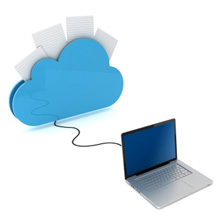Editor’s Note: This guest post is written by Uzi Shmilovici, the founder and CEO of Future Simple, the company behind Base CRM.
The first image that comes to my mind when I think about business computing is the dystopic scene from the 1984 Apple commercial: A swarm of employees wearing the same uniforms and marching in unison into their offices where they are forced to use certain devices and software.
They sit down in front of their PCs, open a business application their company paid millions of dollars to implement and, in a disciplined manner, fill out forms to populate the company’s database so their managers will be happy.
The Anya Major in this dystopic scene is the consumerization of enterprise software. The term “consumerization” was first used, in the context of enterprise software, by Kevin Efrusy from Accel Partners back in 2008. You probably heard about it before. Heck, there’s even a SXSW panel discussing this subject, which means it really went mainstream. What is missing from the conversation though is a good look at the root causes and more importantly, at the implications of this phenomenon.
Why is consumerization accelerating?
There are three key paradigm shifts that accelerate the consumerization of business software:
- The devices we use — would you rather use a Dell desktop computer or an iPad? Well, many people carry their iPads to work. Others carry an iPhone or Android device, even if they also have to carry their company’s Blackberry device. As a result, companies adapt and buy the devices their employees would use anyway. That’s why SAP’s CIO purchased 40,000 iPads. It is a bottom-up decision made by the employees and not the CIO.
- The way we work — Twitter turned out to be a fantastic collaboration tool that allowed a real-time flow of information between people. Yammer emerged to do that in the enterprise. Evernote is a fantastic tool for note taking. Why use anything else in your work environment? Dropbox is the best consumer online file sync solution. Sure, you can use that overly complex enterprise storage server with four levels of authentication. Or not.
The consumerization of collaboration and productivity tools starts with small workgroups that adopt a specific tool. At some point, the CIO notices that different groups are using the same external product. This means that the company’s data is not centralized anymore which is not making the CIO happy.
Add to that the fact that these startups learned how to talk to the hearts of these CIOs and you get Sponsored Evernote Accounts, Dropbox For Teams and Yammer Enterprise Edition.
- The way we interact with software — It is NOT fun to use Path 2.0 on your way to work and then open a traditional business application once you get there. We’re seeing use cases in which people use consumer apps or new generation business apps for their daily needs and then dump data into bloated enterprise software on a monthly basis because they have to. This will continue until this new user experience paradigms make their way into current enterprise software, or more likely, new enterprise software makes its way into the enterprise.
What does this mean for business computing?
The “cloud” and the Software as a Service model were the last innovations in enterprise software. There were not a lot of changes in other aspects of the software though. For most, they remind dull applications running on regular PC computers and sold to CIOs. Consumerization is changing that and is doing it fast.
Here are three predictions on how consumerization will change the face of business computing forever:
- A new class of enterprise software — With the cost of building and serving great software going down and the new user experience paradigms becoming more pervasive, a new generation of business software emerges. With a strong focus on user experience and on making the software useful for the users themselves and not only to their managers, this type of software accelerates adoption and provide 10X the value for a fraction of the cost.
- Dramatic shift in discovery channels — CIO magazines are great but today people find new apps via social media, peer recommendations, search or, increasingly, through the various app stores. There’s no need for a special committee to choose the right software when you can rely on credible ratings and recommendations. The employees bring their apps and collaboration tools from home and effectively make the decision for the enterprise.
- Failure of traditional vendors to adopt — Don’t want to name names but it is absolutely insane that most of the traditional vendors failed to put together good mobile apps. Truth is that it is not easy to do when you are sitting on top of a complex legacy code that barely runs in a modern browser, let alone on a new device.
It will take another 3-5 years but it is inevitable. The revolution is already here and like always it starts from the bottom, with new and smaller companies adopting new apps. It will then move quickly upstream to medium businesses and eventually to bigger enterprises. The devices and software that we will use in our work environments will be dramatically different.
True, this might not be as exciting as Unicorns boards on Pinterest and many people ask me why I’m in the business of enterprise software vs. being in the consumer internet. My answer is that I’m in the business of people. Happy, productive, empowered people that have the freedom to choose great software.
Image credit Moxiesoft.com
